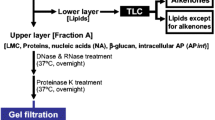Abstract
Navicula pelliculosa and an associated Flavobacterium sp. were isolated from the epiphyton of Scirpus maritimus, an emergent macrophyte growing in a brackish drainage dyke. Both micro-organisms possessed active transport systems for glucose uptake. In N. pelliculosa the transport system was fully induced in the dark in the absence of glucose, and subsequently inactivated when transferred to the light in the absence of the substrate. The presence of glucose during the dark induction period prevented the achievement of maximum specific activity of the transport system, while incubation at a high light intensity with or without the presence of the substrate resulted in a very marked inhibition of glucose uptake. Inhibition in the light was partially offset by blocking photosynthetic electron flow with 3′(3,4-dichlorophenyl) 1′1′ dimethyl urea. The transport system accumulated 3-O-methyl glucose against a concentration gradient and was highly specific for glucose as there was no competition by most of the other sugars tested. However, 6-deoxyglucose was taken up instead of glucose and this suggested that glucose was transported in a non-phosphorylated state, whereas inhibition of glucose transport activity with dicyclohexylcarbodimide implicated the involvement of an adenosine triphosphatase on the cell membrane. Inhibitors of oxidative phosphorylation tetrachlorosalicylaniline and carbonylcyanide m-chlorophenylhydrozone also inhibited glucose transport activity.
The affinity of the diatom for glucose was greater than that shown by the bacterium, but the K m for glucose transport, 1.5×10-5M was too high to allow effective removal of glucose at in situ concentrations.
Similar content being viewed by others
Abbreviations
- D.C.M.U.:
-
3′(3,4-dichlorophenyl)1′,1′ dimethyl urea
- D.C.C.D.:
-
dicyclohexylcarbodiimide
- C.C.C.P.:
-
carbonylcyanide m-chlorophenylhydrazone
- T.C.S.:
-
tetrachlorosalicylaniline
- A.S.W.:
-
artificial sea water
References
Allen, H. L.: Primary productivity, chemo-organotrophy and nutritional interactions of epiphytic algae and bacteria on macrophytes in the littoral of a lake. Ecol. Monogr. 41, 97–127 (1969)
Fruton, J. S., Simmonds, S.: General biochemistry, 2nd ed. New York: Wiley 1958
Gingras, G., Lemasson, C.: A study of the mode of action of CMU on photosynthesis. Biochim. biophys. Acta (Amst.) 109, 67–78 (1965)
Guillard, R. R. L., Ryther, J. H.: Studies of marine planktonic diatoms. I. Cyclotella nana Hustedt and Detonula conferiacea (Cleve) Gran. Canad. J. Microbiol. 8, 229–239 (1962)
Harold, F. M., Baarda, J. R.: Inhibition of membrane transport in Streptococcus faecalis by uncouplers of oxidative phosphorylation and its relationship to proton conduction. J. Bact. 96, 2025–2034 (1968)
Hellebust, J. A.: Kinetics of glucose transport and growth of Cyclotella cryptica. Reimann, Lewin, and Guillard. J. Phycol. 7, 1–4 (1971a)
Hellebust, J. A.: Glucose uptake by Cyclotella cryptica: dark induction and light inactivation of transport system. J. Phycol. 7, 345–349 (1971b)
Jones, A. K., Rhodes, M. E., Evans, S. C.: the use of antibiotics to obtain axenic cultures of algae. Brit. phycol. J. 8, 185–196 (1973)
Komor, E., Tanner, W.: Characterisation of the active hexose transport system of Chlorella vulgaris. Biochim. biophys. Acta (Amst.) 241, 170–179 (1971)
Komor, E., Tanner, W.: The nature of the energy metabolite responsible for sugar accumulation in Chlorella vulgaris. Z. Pflanzenphysiol. 71, 115–128 (1974)
Kundig, W., Gosh, S., Roseman, S.: Phosphate bound to histidine in a protein as an intermediate in a novel phosphotransferase system. Proc. nat. Acad. Sci. (Wash.) 52, 1067–1074 (1964)
Lewin, J. C.: Heterotrophy in diatoms. J. gen. Microbiol. 9, 305–313 (1953)
Lylis, J. C., Trainor, F. R.: The heterotrophic capabilities of Cyclotella meneghiniana. J. Phycol. 9, 365–369 (1973)
Parsons, T. R., Strickland, J. D. H.: On the production of particulate organic carbon by heterotrophic processes in seawater. Deep-sea Res. 8, 211–222 (1962)
Provasoli, L., McLaughlin, J. J. A., Droop, M. R.: Development of artificial media for marine algae. Arch. Mikrobiol. 25, 392–428 (1957)
Romano, A. H., Eberhard, S. J., Dingle, S. L., McDowell, T. D.: Distribution of the phosphoenolpyruvate: glucose phosphotransferase system in bacteria. J. Bact. 104, 808–813 (1970)
Sheath, R. G., Hellebust, J. A.: Glucose transport system and growth characteristics of Bracteococcus minor. J. Phycol. 10, 34–41 (1974)
Tanner, W., Grunes, R., Kandler, O.: Specificity and turnover of inducible hexose uptake systems of Chlorella. Z. Pflanzenphysiol. 62, 376–386 (1970)
Vaccaro, R. F., Jannasch, H. W.: Studies on heterotrophic activity in seawater based on glucose assimilation. Limnol. Oceanogr. 11, 596–607 (1966)
White, A. W.: Uptake of organic compounds by two facultative heterotrophic marine centric diatoms. J. Phycol. 10, 433–438 (1974)
Wright, R. T., Hobbie, J. E.: The uptake of organic solutes in lake water. Limnol. Oceanogr. 10, 22–28 (1965)
Wright, R. T., Hobbie, J. E.: Use of glucose and acetate by bacteria and algae in aquatic ecosystems. Ecology 47, 447–464 (1966)
Author information
Authors and Affiliations
Rights and permissions
About this article
Cite this article
Jolley, E.T., Jones, A.K. & Hellebust, J.A. A description of glucose uptake in Navicula pelliculosa (Breb) hilse including a brief comparison with an associated Flavobacterium sp.. Arch. Microbiol. 109, 127–133 (1976). https://doi.org/10.1007/BF00425124
Received:
Issue Date:
DOI: https://doi.org/10.1007/BF00425124




